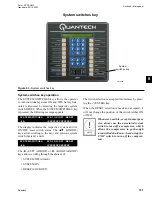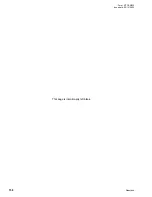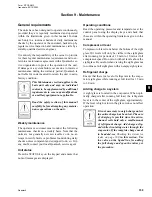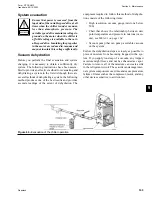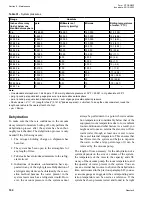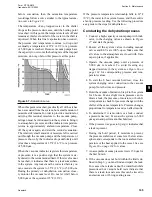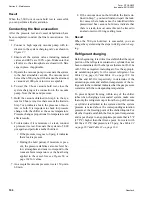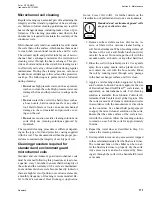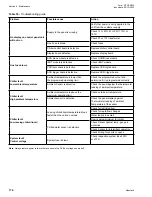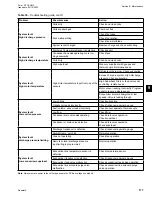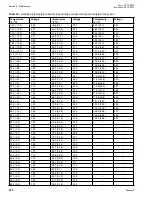
Section 9 - Maintenance
Quantech
169
Form QTC4-NM2
Issue date: 05/12/2023
9
The refrigerant charge is specified for each chiller
model on the unit data plate or in the factory order form
(FOF) that is provided for every new sale. Charge the
chiller based on the amount specified in the FOF less
10%. For example, for a chiller that requires 500# of
refrigerant, the initial refrigerant charge is 450#, 500
- 50 = 450. This allows room to trim the charge as out-
lined in
Checking and trimming the refrigerant charge
Charge the refrigerant in accordance with the method
shown in this section. The weight of the refrigerant
charged must be recorded after the initial charging.
Use the next section for trimming the chiller for opti-
mum operation based on the defined indicators, such
as discharge superheat, sub-cooling, and approaches.
Removing the refrigerant charge for
service
To avoid the possibility of freezing liquid
within any of the chiller tubes when
removing refrigerant from a charged
system, the required method is to run the
chilled water pumps during this process to
eliminate the risk of tube freezing during
the recovery process. The chilled liquid
flow must remain present for the entire
refrigerant recovery process. If water flow
cannot be maintained, it is imperative that
the chilled liquid is completely drained
from the chiller and the waterbox vents
and drains are all open before beginning
this process.
Before the removal of any charge into the containers,
for optimal performance, use an empty, fully evacuated
refrigerant container. This ensures that the container is
not contaminated and aids in the efficient removal of
refrigerant.
Before removing any refrigerant, establish the start-
ing weight (tare weight) for the refrigerant cylinder
and log the final weight for each container that is used
for the recovery. This ensures that the correct weights
are noted for determining the chiller refrigerant charge
amount.
Refrigerant weight = Total Container
Weight – Tare Weight
While handling refrigerant into or out of any chiller,
every precaution must be taken to prevent air from
entering the system when handling the charging lines.
Create a suitable charging connection from new copper
tubing or correctly selected flexible charging hoses. Fit
this charging connection between the system service or
charging valves and the fitting on the refrigerant con-
tainer. This connection must be as short as possible but
long enough to provide sufficient flexibility for chang-
ing containers. It must also contain a tee fitting with a
valve that can serve as a connection point to a vacuum
pump to evacuate the charging lines.
The charging connection must be evacuated each time
the lines are disconnected for changing cylinders or any
of the components of the charging process. The charg-
ing line for the refrigerant liquid must also contain a
sight glass. When liquid refrigerant is being handled,
the sight glass can be monitored to determine when
the liquid is no longer being transferred to or from the
chiller.
To remove refrigerant from the evaporator, complete
the following steps:
1. Turn the chilled liquid pump on and ensure the
flow is above the minimum recommended flow.
2. Ensure all the system valves including manual
valves and EEVs are 100% open.
3. Connect the recovery unit and a manifold gauge
to the liquid line feeding the eductor. There may
be a valve in the line or a Schrader fitting on the
eductor filter for this purpose.
4. Connect the recovery unit to a recovery cylinder
sitting on an accurate scale. Turn the recovery unit
on and observe the liquid refrigerant flowing from
the line into the cylinder. The flow of liquid is ob
-
vious.
5. Monitor the pressure gauge to ensure that the
pressure does not drop below the freeze point of
the chilled liquid. Throttle the flow as needed with
the manifold gauge valves to prevent pressures
from dropping below the freeze point.
6. Continue to remove the liquid refrigerant while
observing the flow and the pressure. Note the
charge in the system based on the nameplate data
to determine when the charge removal is nearly
complete. Monitor the weight of the recovery
cylinder to determine when the cylinder is full.
Change the cylinder as needed.
Содержание QTC40160
Страница 22: ...Quantech 22 Form QTC4 NM2 Issue date 05 12 2023 This page is intentionally left blank...
Страница 94: ...Quantech 94 Form QTC4 NM2 Issue date 05 12 2023 This page is intentionally left blank...
Страница 100: ...Quantech 100 Form QTC4 NM2 Issue date 05 12 2023 This page is intentionally left blank...
Страница 158: ...Quantech 158 Form QTC4 NM2 Issue date 05 12 2023 This page is intentionally left blank...
Страница 187: ...Quantech 187 Form QTC4 NM2 Issue date 05 12 2023 This page is intentionally left blank...



